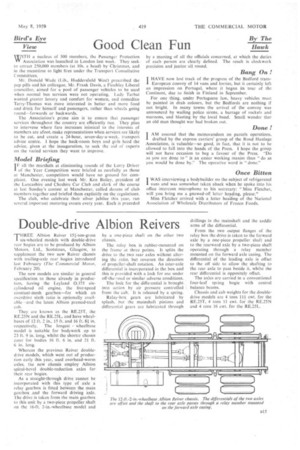Double-drive Albion Reivers
Page 49

If you've noticed an error in this article please click here to report it so we can fix it.
THREE Albion Reiver 154--ton-gross
six-wheeled models with double-drive rear bogies arc to be produced by Albion Motors, Ltd., Scotstoun, Glasgow, to supplement the two new Reiver chassis with trailing-axle rear bogies introduced last February (The Commercial Motor, February 20).
The new models are similar in general specification to those already in production, having the Leyland 0.375 sixcylindered oil engine, the five-speed constant-mesh gearbox—for which an overdrive sixth ratio is optionally available----and the latest Albion pressed-steel cab.
They are known as the RE.25T, the RE.25N and the RE.25L, and have wheelbases of 12 ft. 2 in., 15 ft. and 16 ft. 81 in.
respectively. The longest wheelbase model is suitable for bodywork up to• 23 ft. 9 in. long, whilst the shorter chassis cater for bodies 16 ft, 6 in. and 21 ft. 6 in. long.
Whereas the previous Reiver double. drive models, which went out of production early this year, used overhead-worm axles, the new chassis employ Albion spiral-bevel double-reduction axles for their rear bogies.
As a straight-through drive cannot be incorporated with this type of axle a relay gearbox is fitted between the main gearbox and the forward driving axle. "l'he drive is taken from the main gearbox to this unit by a two-piece propeller shaft on the I 6-ft. 2-in.-wheelbase model and by a one-piece shaft on the other two chassis.
The relay box is rubber-mounted on the frame at three points. It splits the drive to the two rear axles without altering the ratio, but reverses the direction of propeller-shaft rotation. An inter-axle differential is incorporated in the box and this is provided with a lock for use under off-the-road or similar' adverse. conditions.
The lock for the differential is brought into action by air pressure controlled from the cab. It is released by a spring.
Relay-box gears are lubricated by splash, but the mainshaft pinions and differential gears are lubricated through drillings in the raainshaft and the saddle arms of the differential.
From the two output flanges of the relay box the drive is taken to the forward axle by a one-piece propeller shaft and to the rearward axle by a two-piece shaft operating through a relay member mounted on the forward axle casing. The differential of the leading axle is offset to the off side to allow the shafting to the rear axle to pass beside it, whilst the rear differential is oppositely offset.
The axles are carried in a conventional four-leaf spring bogie with central balance beams.
Chassis and cab weights for the doubledrive models are 4 tons 111 cwt. for the RE.25T, 4 tons 11 cwt. for the RE.25N and 4 tons 16 cwt. for the RE.25L.




































































































